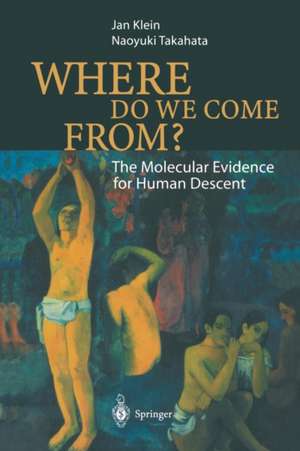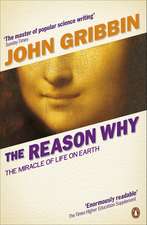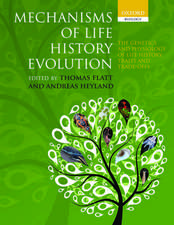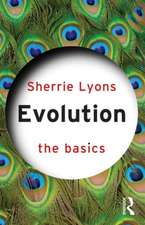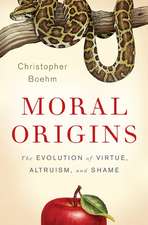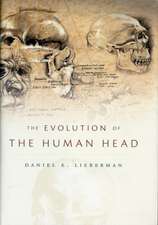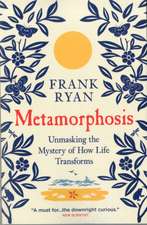Where Do We Come From?: The Molecular Evidence for Human Descent
Autor Jan Klein, Naoyuki Takahataen Limba Engleză Paperback – 22 sep 2011
Preț: 735.38 lei
Preț vechi: 896.81 lei
-18% Nou
Puncte Express: 1103
Preț estimativ în valută:
140.71€ • 153.33$ • 118.57£
140.71€ • 153.33$ • 118.57£
Carte tipărită la comandă
Livrare economică 23 aprilie-07 mai
Preluare comenzi: 021 569.72.76
Specificații
ISBN-13: 9783642076459
ISBN-10: 3642076459
Pagini: 462
Ilustrații: XIII, 462 p. 670 illus., 587 illus. in color.
Dimensiuni: 155 x 235 x 30 mm
Greutate: 0.67 kg
Ediția:Softcover reprint of the original 1st ed. 2002
Editura: Springer Berlin, Heidelberg
Colecția Springer
Locul publicării:Berlin, Heidelberg, Germany
ISBN-10: 3642076459
Pagini: 462
Ilustrații: XIII, 462 p. 670 illus., 587 illus. in color.
Dimensiuni: 155 x 235 x 30 mm
Greutate: 0.67 kg
Ediția:Softcover reprint of the original 1st ed. 2002
Editura: Springer Berlin, Heidelberg
Colecția Springer
Locul publicării:Berlin, Heidelberg, Germany
Public țintă
Professional/practitionerCuprins
1 A Tahitian Prelude Art, Myth, and Science.- 2 Bridging the Generation Gap The Physical Basis of Ancestor-Descendant Relationship.- 3 Crane’s Foot Biological Meaning of Descent.- 4 Klados and Phylé The Molecular Nature of Evolution.- 5 The Painted Tree Methods of Phylogenetic Reconstruction.- 6 The Tree of Life From the Root to the Crown.- 7 The Rise of the Metazoan Tribes The New Phylogeny of the Animal Kingdom.- 8 Our Place in Nature The Closest Living Relative.- 9 Of Time and the Tree The Time Scale of Evolution.- 10 The Narrow Road to the Deep North Hominids and the Origin of Homo sapiens.- 11 Through the Neck of a Bottle The Genesis and the Genetic Nature of Homo sapiens.- 12 Who Are We? Where are We Going? The Present Condition and the Future of Our Species.- Appendix One.- Appendix Two.- Appendix Three.- Appendix Four.- Appendix Five.- Sources and Further Reading.- Illustration and Quotation Credits.
Recenzii
From the reviews of the first edition:
"This is a beautiful and beautifully written book about molecular approaches to the study of evolution. … The authors’ love of science and their belief in straightforward reporting pervade the book. … As the authors intended, this is the book that intelligent people, willing to put a little effort into it, should read to learn about the current state of molecular perspectives on evolution. It is a masterful piece of work and I recommend it without reservation." (Henry Harpending, BioEssays, Vol. 26 (6), 2004)
"In their new book, Where Do We Come From? The Molecular Evidence for Human Descent, the authors merge literary, artistic, and mythological perspectives on human origins with a comprehensive look at the molecular evolutionary history of our species. The result is a wide-ranging, and very impressive, ‘textbook’. … While written with the nonspecialist clearly in mind, anyone with an interest in human evolution, and the molecular data that relate to it, will find much to occupy and entice them in this book." (S. M. Fullerton, Heredity, Vol. 90, 2003)
"The title for this most fascinating and well-written book comes from the title of Gauguin’s last great masterpiece, D’où Venons-Nous? Que Sommes-Nous? Où Allons-Nous?, painted in Tahiti in 1897 … . The painting, which is reproduced in the book … depicts the myth of creation … . The book is lavishly produced, is over 450 pages long and includes dozens of tables, graphs, maps and other figures. … Where do we come from? would be an excellent textbook for college/university students studying genetics." (Trefor Jenkins, Human Genetics, Issue 111, 2002)
"Jan Klein is a renowned immunologist … . His new book is co-authored by Naoyuki Takahata … . It tells the story of human descent on Earth over the past four billion years … . This book contains an enormous amount of information, and anyone who masters theentire book would know a great deal about human evolution as well as molecular evolution. … So my advice to the reader is: be patient and enjoy this deeply scientific and superbly artistic book." (Masatoshi Nei, Nature, Vol. 417, 2002)
"This is a beautiful and beautifully written book about molecular approaches to the study of evolution. … The authors’ love of science and their belief in straightforward reporting pervade the book. … As the authors intended, this is the book that intelligent people, willing to put a little effort into it, should read to learn about the current state of molecular perspectives on evolution. It is a masterful piece of work and I recommend it without reservation." (Henry Harpending, BioEssays, Vol. 26 (6), 2004)
"In their new book, Where Do We Come From? The Molecular Evidence for Human Descent, the authors merge literary, artistic, and mythological perspectives on human origins with a comprehensive look at the molecular evolutionary history of our species. The result is a wide-ranging, and very impressive, ‘textbook’. … While written with the nonspecialist clearly in mind, anyone with an interest in human evolution, and the molecular data that relate to it, will find much to occupy and entice them in this book." (S. M. Fullerton, Heredity, Vol. 90, 2003)
"The title for this most fascinating and well-written book comes from the title of Gauguin’s last great masterpiece, D’où Venons-Nous? Que Sommes-Nous? Où Allons-Nous?, painted in Tahiti in 1897 … . The painting, which is reproduced in the book … depicts the myth of creation … . The book is lavishly produced, is over 450 pages long and includes dozens of tables, graphs, maps and other figures. … Where do we come from? would be an excellent textbook for college/university students studying genetics." (Trefor Jenkins, Human Genetics, Issue 111, 2002)
"Jan Klein is a renowned immunologist … . His new book is co-authored by Naoyuki Takahata … . It tells the story of human descent on Earth over the past four billion years … . This book contains an enormous amount of information, and anyone who masters theentire book would know a great deal about human evolution as well as molecular evolution. … So my advice to the reader is: be patient and enjoy this deeply scientific and superbly artistic book." (Masatoshi Nei, Nature, Vol. 417, 2002)
Caracteristici
There are many popular books on the origin of the human species, but the majority are focused on the testimony provided by old bones, while molecular evidence is merely skimmed over With the present book it is just the reverse: although the archeological and paleontological evidence is summarized, its marrow is the information provided by molecules, first and foremost nucleic acids
